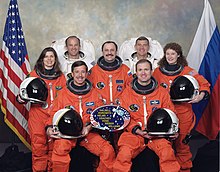STS-101

The launch of STS-101
|
|||||
| Mission type | ISS assembly/logistics | ||||
|---|---|---|---|---|---|
| Operator | NASA | ||||
| COSPAR ID | 2000-027A | ||||
| SATCAT № | 26368 | ||||
| Mission duration | 9 days, 21 hours, 10 minutes, 10 seconds | ||||
| Distance travelled | 6.6 million kilometres (4.1 million miles) | ||||
| Orbits completed | 155 | ||||
| Spacecraft properties | |||||
| Spacecraft | Space Shuttle Atlantis | ||||
| Landing mass | 100,369 kilograms (221,276 lb) | ||||
| Payload mass | 1,801 kilograms (3,971 lb) | ||||
| Crew | |||||
| Crew size | 7 | ||||
| Members |
James D. Halsell, Jr. Scott J. Horowitz Mary E. Weber Jeffrey N. Williams James S. Voss Susan J. Helms Yury V. Usachev |
||||
| EVAs | 1 | ||||
| EVA duration | 6 hours, 44 minutes | ||||
| Start of mission | |||||
| Launch date | 19 May 2000, 10:11 UTC | ||||
| Launch site | Kennedy LC-39A | ||||
| End of mission | |||||
| Landing date | 29 May 2000, 06:20 UTC | ||||
| Landing site | Kennedy SLF Runway 15 | ||||
| Orbital parameters | |||||
| Reference system | Geocentric | ||||
| Regime | Low Earth | ||||
| Perigee | 319 kilometres (198 mi) | ||||
| Apogee | 332 kilometres (206 mi) | ||||
| Inclination | 51.5 degrees | ||||
| Period | 91.04 minutes | ||||
| Epoch | 21 May 2000 | ||||
| Docking with ISS | |||||
| Docking port |
PMA-2 Unity forward |
||||
| Docking date | 20 May 2000, 04:30 UTC | ||||
| Undocking date | 26 May 2000, 23:03 UTC | ||||
| Time docked | 5 days, 18 hours, 32 minutes | ||||
|
|
|||||


STS-101 crew (left to right): Weber, Williams, Horowitz, Usachev, Voss (in white suit), Halsell, Helms
STS-101 was a Space Shuttle mission to the International Space Station (ISS) flown by Space Shuttle Atlantis. The mission was a 10-day mission conducted between 19 May 2000 and 29 May 2000. The mission was designated 2A.2a and was a resupply mission to the International Space Station. STS-101 was delayed 3 times in April due to high winds. STS-101 traveled 4.1 million miles and completed 155 revolutions of the earth and landed on runway 15 at Kennedy Space Center. The mission was the first to fly with the "glass cockpit".
STS-101 delivered supplies to the International Space Station, hauled up using a Spacehab double module and an Integrated Cargo Carrier pallet. The crew performed a spacewalk and then reboosted the station from 230 miles (370 km) to 250 miles (400 km).
Detailed objectives included ISS ingress/safety to take air samples, monitor carbon dioxide, deploy portable, personal fans, measure air flow, rework/modify ISS ducting, replace air filters, and replace Zarya fire extinguishers and smoke detectors. Critical replacements, repairs and spares were also done to replace four suspect batteries on Zarya, replace failed or suspect electronics for Zarya's batteries, replace Radio Telemetry System memory unit, replace port early communications antenna, replace Radio Frequency Power Distribution Box and clear Space Vision System target.
...
Wikipedia
